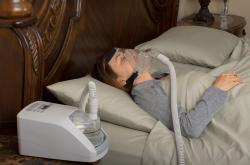Arranging Your Bedroom For Optimum Sleep
Having a bedroom that’s conducive to sleep is really important if you’re in recovery from tiredness. Here are some tips for making your bedroom a perfect sleeping chamber.
If you’re suffering from tiredness, you’ll know how important high quality sleep is. Good quality sleep refreshes us in a way that nothing else can, so it’s really important to get as much as possible on a regular basis.
It is well worth the time and effort of arranging your life and your home so that both are as sleep-promoting as possible. In addition to preparing yourself (seeRaising the quality of your sleepfor how to do this), you’ll also need to prepare your environment and make sure that it’s restful, cool and quiet. There are a number of things you’ll want to take into consideration including: the bedroom itself, the bed and bed linen, the light, ventilation, safety and noise issues.
From bedroom to sleeping chamber
In German, the bedroom is literally translated as ‘the sleeping chamber’, which underscores the importance of the activity which will take place in the room. Aim to make your bedroom into a high quality sleeping room.
If you are able to, try to choose a bedroom which is quiet and away from noisy traffic, elevator sounds or other people. If this isn’t possible, then you may have to find some way of blanking out the noise from the road. You may consider having double glazing or shutters fitted. White noise machines which screen out or mask much of the unwanted noise can really help with this problem. So can simple, but well-fitting, earplugs. Both solutions are also helpful if you have a spouse who snores.
You may have to find polite ways of asking your neighbors to refrain from making loud noises after a certain time in the evening, or asking family members to respect the fact that you don’t want to be disturbed after a certain hour. Remember that sleep is a health issue, not just a lifestyle choice and that your future health and recovery from tiredness depend upon getting enough refreshing sleep.
Your bedroom should be calm and restful. Decorate it in calm colors, rather than vibrant ones.Don’t leave unpaid bills and other reminders of task, which have to be done, lying around. The light in your bedroom should be soft and not harsh or bright. You should limit activities in it to sleeping and sexual intercourse. Don’t watch television, or work in your bedroom. It should be a place for relaxation only.
Bed and bed linen
Many of us struggle along on less than comfortable beds. A mattress should be changed at least every ten years.
It’s worth spending as much money as possible on a bed which will offer the best quality of support. Considering that you’re going to be spending at least 30% of your life in your bed, take plenty of time to make a good choice. If you share a bed, you should lie down with your partner in the store because only by doing that can you check if the mattress will support both of you comfortably.
Always buy the best quality you can. However, the key to the bed is the mattress, so if you can’t afford to replace the whole bed, you might want to explore the option of buying a good mattress and putting it on a simple wooden frame or platform.
Replace pillows frequently and before they become saggy and lumpy. After a few years, pillows become filled with dust mites, which can cause allergies. (You can protect you mattress with specially designed cover that will prevent dust mites from getting into it.)
When you’re choosing bed linen, aim for natural fibers rather than synthetic ones (unless you have allergies). Cotton sheets are pleasant to sleep in and are much preferable to synthetic materials because they breathe, allowing us to be cooler in the hot months. Some people prefer sheets and blankets, others prefer quilts and comforters. Whichever you choose, make sure that you can easily add or remove a layer if you need to.
It really helps to clean your room on a regular basis because dust and dirt can hinder breathing. Always air your bed and your bedroom when you get up in the morning so that all the moisture of the night can dry off.
Cool, dark, airy and safe
To sleep well, you will need to be cool (the bedroom should be 5 to 10 degrees cooler than the living room). The temperature shouldn’t fall too much in the night, however, because if it becomes very cold, you may wake up shivering. If you need to have central heating on all night because of the climate, then consider some form of humidification. Otherwise, you will wake up with dry airways. It could be as simple as leaving a bowl of water next to the radiator.
Having a constant source of fresh air is most important. Leaving a window open is the best way to do this, but you may not be able to for safety or noise reasons. If you live on the ground floor, then have some extra security fitted to the window, such as a grille. If for some reason it’s not possible to sleep with a partially open window, consider the possibility of leaving the door to your bedroom open. This way, you will get some air circulating from the rest of your home. Another way round the fresh air issue is to buy an ionizing air cleaner. These machines, some of which are very reasonably priced, freshen the air by generating ions. It can be a little like going to sleep by a waterfall!
The last and most crucial point to be considered is light. Light can be very disturbing. Make sure that your drapes exclude the light from street lights etc. effectively. Consider adding a layer of black-out material to them, if they don’t. Look round your bedroom for any little lights that may be on all night. Phones, chargers, televisions, computers, clocks and radios all have small LEDs in them which can be extremely disruptive of a good night’s rest. Banish them from your sleeping room! There will be plenty of time during the day to enjoy them.
To sum up, the more effort you can put into creating a relaxing, comfortable bedroom, the greater your chance of having restful, high quality sleep.





.jpg)











Leave a comment